Introduction
Overview
KGS maintains 16 technical- and 5 research-, and 7 regional & other technical- committees, covering all areas in geotechnical engineering. Each committee is as listed below. The roles of the technical and research committees are to a) promote close collaboration between researchers and practitioners in various fields and b) disseminate state-of-the-art technology into current practice. The regional & other technical committees aim to exchange local issues and to collaborate among researchers. In addition, KGS is encouraging the participation of female geotechnical engineers by organizing the Geo-Women committee for women. Each committee is organized and maintained independently, holding regular seminars and other research activities. In addition, inter-committee research seminars and meetings are regularly organized to exchange the new ideas and promote inter-committee research.
Technical committees (Please click on each committee for details)
Foundations
Slope Stability
Soft Ground Improvement
Rock & Geology Ground Excavation
Soil Dynamics & Geotechnical Earthquake Engineering
Ground Investigation
Convergence Geo-technique & IT
Offshore & Coastal Engineering
Geo-synthetics
Tunnel
Dams & Levees
Hazard Prevention
Energy & Plant Engineering
Geoenvironmental Engineering
Geomechanics & Unsaturated Soil
Rock Mass & Geology

[The Technical Committee of Foundations]
○ Purpose of establishment
“Foundation is no better than its supporting soil, the structure no better than its foundation”: this phrase emphasizes the role of foundation engineering in which the upper structures can only function properly when the foundations are strong. Foundation systems should be economical while achieving structural stability and serviceability in various load cases and underground conditions. Research and development in foundation engineering are critical to face challenging construction sites such as deep soft ground, deep marine sediments, and extensive underground excavation, which are normally avoided due to technical and economical issues. Furthermore, diverse applications in civil engineering involve new researches that can provide new, safe, and economical techniques for mega foundations such as skyscrapers, offshore foundations such as bucket foundations and floating foundations for wind turbine and platforms, and foundation reinforcements of improving old structures.
○ Main topics
The technical committee for foundation engineering periodically helps the civil engineering society by holding committee meetings and academic seminars to share state-of-art advancements and research outputs in the field of foundations. In addition, the technical committee aims to contribute to the civil engineering industry by sharing case studies of practical applications at construction sites and foundation-related technical works.
- ① Holding periodic meetings and academic seminars to share the state-or-art technologies in the field of foundations.
- ② Organizing site tours for sharing the example of applying the state-of-art technologies
- ③ Revising/establishing national construction standards of foundations and implementing research for foundations
- ④ Arranging continuous technical exchanges with other technical committees and academic conferences
<Committee Chair>
ㅇ Dr. Jongbae Park (LHRI, e-mail: jbpark@lh.or.kr)
 |
 |
| <Observation and workshop of the large-scale pile head reinforcement test by the Foundation TC (2022)> | |

[The Technical Committee of Slope Stability]
○ Purpose of establishment
Slope Stability Technical Committee is a society of experts in the field of slope stabilization which is active in various fields of industry, academia and research affiliated with Korean Geotechnical Society. The committee aims towards contributing to society and the nation as well as towards the development of the Society by promoting academic and technological development in the field of slope stability. It also hopes to improve the qualifications of engineers, and is leading the activation of technical exchanges in the field of slope stabilization within the academic society.
○ Major activities
- ① Promotion of academic activities (hosting of academic presentations, operation of specialized sessions for academic presentations, etc.)
- ② Vitalization of field visits (technical advice through field trips, etc.) for friendship and technology exchange
- ③Committee activities to contribute to the establishment of national standards (revision of slope design standards/specifications, etc.)
- ④ Lectures related to slope stability, training for technicians (slope stability-related seminars, continuing education, etc.)
- ⑤ Research services and external cooperation for the development of related technologies (regularly held joint symposium on slope stability)
<Committee Chair>
ㅇ Ph.D. Hoki Ban (Dept. of Civil Eng., Kangwon National University, e-mail: hban@kangwon.ac.kr)

[The Technical Committee of Soft Ground Improvement]
○ Purpose of establishment of Soft Ground Technical Committee
Since the 1990s, construction of airports and ports, and the expansion of auxiliary facilities have been facilitated by large scale dredging and reclamation processes. In these coastal areas, thick soft soils are deposited, and many geotechnical problems occur during the site development and facility construction, such as large amount of consolidation settlement, circular sliding failure due to insufficient shear strength of soils, lateral displacement, and embankment failure by rapid fill. To minimize the geotechnical problems occurring in soft ground, various alternative methods were introduced, and fields such as site investigation, prediction technology, and filed measurement, which are the fundamentals for understanding soft ground, have rapidly been developed since the 2000s. The Soft Ground Technical Committee was established in 1992 to investigate and solve the geotechnical engineering problems of soft ground, and it is contributing to solving the sub-ground problems of airports, ports, and roads.
○ Technical committee's main topics
This technical committee deals with the geotechnical issues related to soft ground investigation, geotechnical design, and ground improvement which includes,
- ① Prediction of the characteristics of consolidation settlement and lateral displacement by dredging and reclamation,
- ② Study on the characteristics of the construction method on the soft ground alternative method,
- ③ Methods related to investigation technology and interpretation on soft ground,
- ④ Field measurement and prediction technology during embankment and facility construction, and
- ⑤ Revision of design & construction standards and research services.
<The chair of technical committee>
ㅇ Prof. Jaehun Ahn (Pusan National University, e-mail: jahn@pusan.ac.kr)
 |
 |
 |

[The Technical Committee of Rock & Geology Ground Excavation]
○ Purpose of establishment
Until recently, most conventional building in Korea had around 3-4 basement levels, which corresponds to an excavation depth of around 20 meters. However, more recently, deep excavation up to 50 meters have became common amid advancement in design and construction technologies and changes in the social environment, such as undergroundization of public structures. The main concern about ground excavation technology was limited to the stability of retaining structures, but surrounding ground, adjacent structures, and environmental impact have also emerged as essential factors to be considered today amidst widespread urbanization. In particular, the Special Act on Underground Safety legislated in 2018 add more weight to the importance of ground excavation field than ever.
The Committee of Rock & Geology Ground Excavation was established in 1992 with the goal of presenting academic research findings on changes in the social environment, regulations, construction technology advancement related to ground excavation, as well as providing opportunities of information sharing and communication among academia, government organizations, and engineers involved in the construction field. The Committee participate in technical seminars and special sessions at regular symposiums, and also continue discussion and technology exchanges with committees specialized in other fields, thereby expanding its scope of activities and promoting the Korean Geotechnical Society.
○ Main topics
- ① Regulations related to excavation work
- ② Investigation and test for design work
- ③ Types of retaining walls and support system
- ④ Theory of the lateral earth pressure (optimized calculation in rock)
- ⑤ Analysis & prediction on the effect to adjacent structures
- ⑥ Monitoring, data analysis and feedback
- ➆ Research & development of deep excavation methods with the improvement of the involved materials and equipment
<Committee Chair>
ㅇ Junghoon Kim, Ceo (EGENC Co., Ltd. e-mail: egenc21@naver.com)
 |
 |
.png) |
| <oint academic seminar (2006)> | <Special session at symposium(2019)> | <Regular technical seminar (2020)> |

[The Technical Committee of Soil Dynamics & Geotechnical Earthquake Engineering]
○ Purpose of establishment
Soil Dynamics & Geotechnical Earthquake Engineering Committee has been actively conducting academic exchange activities for geotechnical seismic design/performance evaluation and vibration reduction technologies for dynamic loadings since the seismic design was introduced in Korea. As a result, various academic achievements have been derived. Additionally, we are working to advance soil dynamics and seismic engineering technologies through convergence with other engineering disciplines. Soil Dynamics & Geotechnical Earthquake Engineering Committee was established in 1992. After starting with a practical role for the establishment of “Seismic Design Standard Study (II)” in 1997, it has continued close cooperation between industry, academia, and research institutes for the development of performance-based seismic design and ground vibration reduction technology. This committee has made constant efforts to spread leading-edge technologies and to improve seismic design code.
After the 2016 Gyeongju and 2017 Pohang earthquakes, the need for research on domestic seismic design increased rapidly, increasing the role and status of the Soil Dynamics & Geotechnical Earthquake Engineering Committee. The committee is expected to conduct a variety of research activities, such as performance-based seismic design and the revision of the national seismic design code for existing and new facilities in the future.
○ Main topics
- ① Verification of field and laboratory tests for reasonable dynamic soil properties
- ② Verification of the ground response analysis
- ③ Selection of input earthquake motion for nonlinear response history analysis
- ④ Seismic performance assessment for existing and new facilities
- ⑤ Revision of seismic design code
- ⑥ Forums and technical workshops on soil dynamics and geotechnical earthquake engineering.
- ⑦ Session in the annual Spring/Autumn conference of the Korean Geotechnical Society
<Committee Chair>
ㅇ Prof. Yun Wook, Choo (Dep of Civil and Environmental Engineering College of Engineering, Kongju National University , e-mail: ywchoo@kongju.ac.kr)
 |
 |
| <Pannel discussion in Geotechnical Future Forum (2021)> | <Keynote presentation in Geotechnical Future Forum (2021)> |

[The Technical Committee of Ground Investigation]
○ Purpose of establishment
The aim of the Site Investigation Technology Committee is to take the domestic site investigation technology to the next level by exchanging new information between academia and industry about site investigation, including various laboratory and field tests for economical and safe design construction. Recently, the committee is expanding its scope on the management of big data obtained during construction, effective interpretation of heterogeneous site investigation results, and new applications combined with digitalized geotechnical information collection systems in the field.
○ Main topics
- ① Various geotechnical problems relating to Site Investigation
- ② Analysis of geotechnical characteristics of onshore and offshore ground through boring, penetration and physical exploration.
- ③ Site Investigation techniques for groundwater condition and geo-environmental pollution evaluation.
- ④ New concept of Site Investigation technology and equipment development.
- ⑤ Collecting Big data obtained during construction and their efficient usage
<Committee Chair>
ㅇ Prof. Dongyoup Kwak (Dept. Civil & Env. Eng., Hanyang University, ERICA, e-mail: dkwak@hanyang.ac.kr)
 |
 |

[The Technical Committee of Geo-IT Convergence]
○ Purpose of establishment
The Information-Oriented Construction Technology Committee, the predecessor of the Geo-IT Convergence Committee, initiated its activities in March 1992 in accordance with the resolution of the Board of Directors of the Korean Geotechnical Society in September 1991. The name was consequently changed to the current Geo-IT Convergence Committee in December 2009 in order to promote the development of geotechnical engineering through developments in IT technology and convergence with various disciplines and latest technologies.
Currently, the construction sector is striving to improve the low productivity of the Korean construction industry (half of the average of major countries) and secure competitiveness in the rapidly growing smart construction market. It is expected that future demands and technologies for human activities in new areas such as space, polar, abyssal zones, and deep caverns will continue to grow and through such interests advancements in geotechnical engineering technologies is expected.
Currently, the construction sector is striving to improve the low productivity of the Korean construction industry (half of the average of major countries) and secure competitiveness in the rapidly growing smart construction market. It is expected that future demands and technologies for human activities in new areas such as space, polar, abyssal zones, and deep caverns will continue to grow and through such interests advancements in geotechnical engineering technologies is expected.
In response, the Geo-IT Convergence Committee is currently working to meet the current demands by pioneering new fields such as convergence of the geo-technology with high-tech fields (IT, BT, ET).
○ Main topics
- ① Search for the future geotechnical roles through convergence with other professional fields (IT, BT, ET, etc.)
- ② Research and investigation on geotechnical engineering linked to advanced technologies (drone, IoT, big data, AI, etc.)
- ③ Development of policy and technologies to revitalize smart construction technology
- ④ Sharing the latest geotechnical engineering through professional networking, such as activated professional sessions
<Committee Chair>
ㅇ Prof. Taesik Kim (Dept. of Civil Engineering, Hongik University, e-mail: taesik.kim@hongik.ac.kr)

[The Technical Committee of Offshore & Coastal Engineering]
○ Purpose of establishment of
The Committee of Offshore&Coastal Engineering was established under the name Committee of Dredging & Landfill as one of the technical committees maintained by Korean Geotechnical Society in March 1992. Considering international trends, in December 2007 the committee was renamed as “Committee of Offshore&Coastal Engineering” in order to cover a more comprehensive range of concepts in Coastal Geotechinque. The Committee’s activities primarily concern the earnest cooperation with members from related fields, exchange of academic information through technical presentation, technical lesson or field study, researches on technical regulation, and the publishing of reference books. The Committee is also actively participating in external cooperation such as research services.
○ Main topics
- ① Studies on technologies evaluating Offshore & Coastal structures in terms of Geotechnical engineering
- ② Studies on characteristics of Dredging & Landfill in terms of engineering
- ③ Exchange of academic information among members; technical presentation, technical lesson or field study
- ④ Publishment of technical regulation and reference books
- ⑤ External Cooperation; research service on related technological fields
<Committee Chair>
ㅇ Prof. Gigwon Hong (Halla University, e-mail: g.hong@halla.ac.kr)
 |
 |
| <International workshop hosted by the Committee> | <Public hearing on revising technical regulation> |

[The Technical Committee of Geo-synthetics]
○ Purpose of establishment
The main purpose of this committee is promoting academic research and technological development, as well as exchange and dissemination of information on geosynthetics and applied geosynthetics.
○ Main topics
- ① Academic and technological research and development on geosynthetics and applied geosynthetics
- ② Survey, data collection and analysis through industry-university-institute collaboration; establishment of related standards and guidelines
- ③ Outsourcing of research projects, provision of contract research services on geosynthetics and applied geosynthetics, technical consulting
- ④ Advisory services on geosynthetic technologies; proposal of related policies; sponsorship for public welfare projects
- ⑤ Other projects needed to accomplish the purposes of this society
- ➅ Management of the special session in the annual Spring/Autumn Conference of the Korea Geotechnical Society
<Committee Chair>
ㅇ Ph.D. Choo, Hyunwook (Dept. of Civil Eng., Hanyang University, e-mail: choohw@gmail.com)
 |
 |
| <Discussion in Working Committee (2021)> | <Meeting with KGSS (2020)> |

[The Technical Committee of Tunnel]
○ Purpose of establishment
The Committee of Tunnel Technique was established in March 1992 as one of the nine technical committees. It started with the participation of Professor Hyung-Sik Jeong, the first chairperson, and 58 technical committee members.
The Committee joined members interested in tunnel engineering among geotechnical engineering fields to promote mutual cooperation. Information exchange has been promoted through seminar and discussion sessions.
The committee was established to lay the foundation for the convergence of industry and academy by continuously providing in-depth R&D opportunities.
Recently, due to rapid urbanization, there has been insufficient ground space to expand the social infrastructure such as roads, railroads, subways, drains, and electric power outlets. As a result, tunnel technologies that satisfies safety and environment at the same time is greatly required.
The Committee of Tunnel Technique will take a leading role in the technological development of the tunnel field through the sharing of information and technology among industry-academia-research experts, and through this, it intends to contribute to the development and status of the society.
○ Main topics
- ① Tunnel design standard and specification
- ② Tunnel excavation and support
- ③ Mechanized tunnelling in downtown areas
- ④ Tunnel ventilation and disaster prevention
- ⑤ Development of underground space
<Committee Chair>
ㅇ Kang-Hyun Lee, Principal Researcher (Korea Expressway Corporation Research Institute, e-mail: tunnelslope@ex.co.kr)
 |
 |
| <Academic conference Joint academic seminar (2020)> | <Academic conference Joint academic seminar (2021)> |

[The Technical Committee of Dams & Levees]
○ Purpose of establishment
About 18,000 dams and reservoirs and about 35,000 km of river levees constructed in 1960s to 1980s have contributed to Korea's rapid economic and agricultural development by supplying industrial and agricultural water and providing flood control and water-friendly environment. The Dam and Levee Technical Committee was established in 2005 to disseminate information for the improvement of design, construction, operation and maintenance technologies, and to support development or amendment of institutional systems and policies related to dams and levees.
○ Main topics
- ① Leading technology development for design, construction and maintenance of dams and levees and providing technical advisory to the public
- ② Design, construction and maintenance of dams and levees including monitoring, repair and reinforcement technologies
- ③ Laws, systems, policies and standards related to the design, construction and maintenance of dams and levees
- ④ Dissemination, education and training of knowledge, information and practices related to the construction and maintenance of dams and levees
- ⑤ Technical cooperation and advice with government/local governments and facility management entities related to dams and levees
- ➅ Analysis of trends and technology exchanges related to domestic and international incidents/accidents related to dams and levees
<Committee Chair>
ㅇ Dr. Jeong-Yeul Lim (K-water, e-mail: passion@kwater.or.kr)
 |
 |

[The Technical Committee of Hazard Prevention]
○ Purpose of establishment
A range of disasters are rapidly growing due to various natural disasters caused by global climate change and artificial factors such as increases in development and ground deterioration. In particular, increased disasters on the ground, such as landslides and subsidence, cause substantial damage to the national land, people and property, and thus their socio-economical impact is rapidly growing. To overcome this problem, various methods of construction have been developed along with administrative efforts and technical advances through trial and error.
The hazard prevention committee is carrying out a comprehensive range of research activities including investigation on the actual conditions of ground disasters that occur due to various causes, including natural disasters such as typhoons and rainfall, geological characteristics, and artificial development. The committee particularly pursues the execution of a more in-depth and fundamental research in conjunction with research on the understanding of natural phenomena and the mechanisms of disasters in order to identify the association between increased natural disasters attributed to climate change and ground disasters, as well as to establish proper measures.
○ Main topics
- ① Matters on climate change and natural disasters
- ② Matters on the identification of types of ground disasters and mechanisms
- ③ Matters on the investigation and testing of ground-related disaster sites
- ④ Revision of the criteria for ground disaster-related investigations and evaluations
- ⑤ Matters on the countermeasures against ground disasters and construction
- ➅ Hosting of forums and technical training sessions related to measures against ground disasters
<Committee Chair>
ㅇ BANG SEONG TAEK (ILJIN Engineering & Construction, e-mail: bst91@knu.ac.kr)
 |
 |

[The Technical Committee of Energy Plant]
○ Purpose of establishment
Energy Plant Technical Committee was initiated in 2009 in order to provide technical solutions to the design, construction, and maintenance of energy & plant related structures including developments in new innovative systems. Since the first symposium held at commencement to the latest KGS conference in 2021, the committee has been hosting various international and domestic workshops, seminars, and site reconnaissance, and invited experts from industry, academia, officials, and research institutes related to energy-plant related fields to share their knowledge and experience.
Energy Plant Technical Committee has a relatively short history, but a very active membership with enthusiastic contributions of it core members. With 10 plus years of experiences, the committee aims to provide technical support to energy-plant related fields. Since the announcement of Korean government’s “Renewable Energy 3020” plan in 2017 as well as “Green New Deal” plan in 2020, the demands and attentions to renewable energy related technologies have grown. Furthermore, development of disposal technologies for high-level radioactive wastes is really needed.
Therefore, the Energy Plant Technical Committee aims towards promoting the development of technologies in the various alternative energy resources through educating, specializing, socialization of geotechnical engineers.
○ Main topics
Technical supports, research, and development of
- ① Design and construction technologies for onshore/offshore foundation
- ② Design and construction technologies for plant foundations
- ③ Renewable energy technologies
- ➃ High-level radioactive waste disposal technologies
<Committee Chair>
ㅇ Dr. Seok Yoon (Disposal Safety Evaluation R&D Division, Korea Atomic Energy Research Institute, e-mail: syoon@kaeri.re.kr)
 |
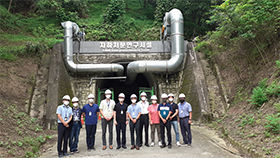 |
| <International Joint Workshop (Energy Plant TC – UWA, 2017)> | <Site visiting to offshore suction pile foundation installation> |

[The Technical Committee of Geoenvironmental Engineering]
○ Purpose of establishment
The Geoenvironmental Engineering Committee was established in 2000 for the purpose of researching the various environmental characteristics on the ground, including general environmental issues relating to geotechnical engineering field. Along with air and water, soil is a major environmental element essential for the survival of living things. However, various kinds of contaminant and industrial waste have been accumulating in the soil, and direct and indirect environmental impacts have occurred as a result. As soil is a finite, non-mobile source, it looses all the functionality to support life once contaminated. Consequently, it generates negative influence and impact on the whole ecosystem. Therefore, the Geoenvironmental Engineering is a collaborative field related to hydraulics, ground-water hydraulics, pedology, chemistry, earth science, biology, and geology based on soil mechanics and foundation engineering. The areas covered in the geoenvironmental field include investigation, measurement and evaluation of geoenvironmental issues, modification of contaminated soil, purification of contaminated groundwater, prevention and monitoring of pollutant dispersion, sampling of contaminated soil, characteristics of waste, advection and diffusion analysis of pollutant, sheltering and prevention technology of soil contamination.
○ Main topics
- ① Collection and analysis of soil contamination and evaluation cases
- ② Case study of restoration of contaminated soil
- ③ Analysis and application of related law and restrictions
- ④ Advection and diffusion of groundwater pollutant
- ⑤ Modelling and numerical analysis of pollutant transport
- ➅ Analysis of wide-range groundwater
<Committee Chair>
ㅇ Prof. Chang-Won Kwak (INHA Technical College, e-mail:geotech@inhatc.ac.kr)

[Geomechanics and Unsaturated Soils Technical Committee]
○ Purpose of establishment
The “Geomechanics and Unsaturated Soils” Technical Committee was established in 2012, unifying the “Geomechanics” and “Unsaturated Soils” committees. The purpose of the committee is to discuss and disseminate research and technical developments in various experimental and numerical methods for the understanding, analysis, and prediction of the fundamental mechanics of soils in geotechnical engineering. The committee deals with unsaturated soil mechanics as one of the main subjects,, and it also regularly interacts with relevant overseas technical committees. Also, because the committee is concerned with subjects on which every geotechnology is based, the committee has a unique feature that it can interact and collaborate with all other technical committees.
○ Main Topics
Technical support, research, and development related to:
- ① TC101: Laboratory Testing
- ② TC103: Numerical Methods in Geomechanics
- ③ TC104: Physical Modelling
- ④ TC105: Geo-mechanics
- ➄ TC106: Unsaturated Soils
<Committee Chair>
ㅇ Prof. Byeong-Su Kim (Department of Civil and Environmental Engineering, Dankook University, Email: bs.kim@dankook.ac.kr)
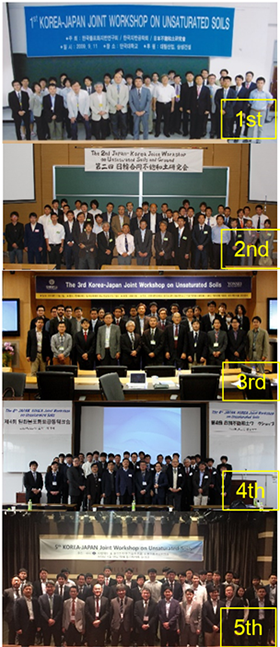 |
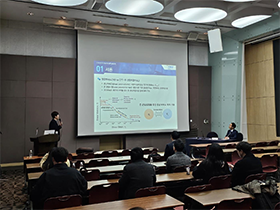 |
| <1st - 5th Korea–Japan Joint Workshop on Unsaturated Soils> | <Special Session: Geomechanics & Unsaturated Soils (2024.03.)> |

[The Technical Committee of Rock Mass & Geology]
○ Purpose of establishment
The technical committee of rock mass & geology was established in 1999. It started with the participation of professor Gyowon Kim, the first chairperson, and technical committee members.
The technical committee was established to promote mutual cooperation and share the technical experiences of rock mass and geology field. The committee deals with geological subjects, engineering subjects, rock mass disasters encountered at the field. Geological field trips and seminars are held regularly.
○ Main topics
- ① Geological and engineering characteristics of rock
- ② Geological and engineering characteristics of discontinuities in rock mass
- ③ Rock mass investigation
- ④ Rock mass classification and rock mass stress
- ⑤ Geological risk and rock mass disaster
<Committee Chair>
ㅇ Dr. Sangrae Lee (Korea expressway corporation, e-mail: lsr8898@ex.co.kr)
 |
 |
| <Book (Geology & Engineering Rock Mass for Geotechnical Engineers) publication> | <Case of Rock Mass Disaster (2018)> |
Research committees (Please click on each committee for details)
Frost Geotechnics
Limit State Design
Electric Power Structures
Transportation Geotechincs
Railroad Geotechnics

[The Research Committee of Frost Geotechnics]
○ Purpose of establishment
It is well known that vast amounts of untapped energy resources are available in the extreme cold regions (Arctic circle) of the world. However, unlike more tropical climates throughout the rest of the world, severe damage caused by frost heaving and thawing subsidence on the frozen ground is severe due to harsh climatic conditions in the Arctic, which in turn causes a lot of damage to roads, railroads, airports, and infrastructures in such regions. Now that construction companies and resource developers have begun to enter the extreme cold regions, research on the engineering characteristics of such climates are necessary.
The research committee of frost geotechnics was established in 2010 and has since been active in analyzing various issues and problems in the extreme cold regions along with formuating possible geotechnical solutions. The committee also plays a role in discovering future geotechnical technologies related to new space development.
○ Main topics
- ➀ Study on the characteristics of the ground in cold regions
- ➁ Methods of the frozen ground assessment and site investigation technology
- ➂ Numerical methods and physical modeling of the frozen ground
- ➃ Thermal stabilized foundation construction technology in cold regions
- ➄ Development of research proposal related to frost geotechnics
<Committee Chair>
ㅇ Prof. Joung-Doung Yu (Dep of Civil Engineering Joongbu University, e-mail: jungdoung@joongbu.ac.kr)

[The Research Committee of Limit State Design]
○ Purpose of establishment
Most subsurface conditions have inherent complex and unpredictable engineering characteristics, as such it is often difficult to make accurate predictions using traditional geotechnical design analysis and approaches. However, by applying new emerging analysis techniques such as geostatistics, data science and machine learning, which are capable of taking these uncertainties and variabilities into consideration, a more objective and efficient engineering design can be formulated. In particular, the application and development of these technologies and design codes has advanced remarkably in the field of geotechnical engineering due to exceptional innovations in computer technology. The Limit State Method Research Committee, which was established in 2013, has since focused on the research and education of such related scientific and engineering topics.
○ Main topics
-
Technical supports, research, development and educations of
- ➀ Geostatistics and probabilistic site characterization
- ➁ Quantification of uncertainties in performance prediction
- ➂ Reliability-based design, Risk-based decision analysis
- ➃ Calibration of LRFD-type geotechnical design codes
- ➄ Forensic geotechnical enginnering
- ➅ Geotechnical applications of data engineering and machine learning techniques
- ➆ ISSMGE partnership technical committees: TC304, TC309, TC205
<Committee Chair>
ㅇ Prof. Hyunki Kim (School of Civil and Environmental Engineering, Kookmin University, e-mail: geotech@kookmin.ac.kr)
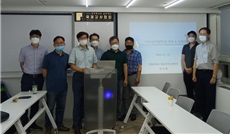
<Technical Seminar on Limit State Design and Forensic Engineering>
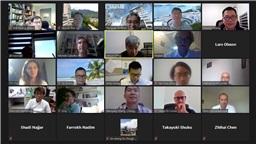
<ISSMGE TC304 Online meeting>

[The Research Committee of Electric Power Structures]
○ Purpose of establishment
Since 1980, KEPCO (korea electric power corporation) started to build cable tunnels in order to provide sufficient and more stable power supplies to the nation due to increasing electric power demand. As of 2020, the total length of trenched cable tunnels is 379km, and the length of trenchless cable tunnels is 195km. Moreover, the length of cable tunnels is continuously increasing. In addition, government plans to build offshore wind power plant complexes on the environmental friendly energy development and zero-carbon policy creates a substantial challenge for the development and maintenance of such power supply systems.
The research committee of electric power structures was established to carry out research on cable tunnel, transmission tower, offshore wind turbine, and their foundations, and to share and communicate with multiple parties across industry, university, research institute, construction, and government. In order to achieve this goal, the committee organizes regular research meetings, job site visits, technical meetings, and it hosts technical seminars and special sessions at regular symposiums to expand our scope of activities and promote the Korean Geotechnical Society.
○ Main topics
- ➀ Design and construction of cable tunnel
- ➁ Design and construction of cable tower and foundation
- ➂ Design and construction of offshore wind turbine tower and foundation
- ➃ Maintenance technology for electric power structures
- ➄ Applications of 4IR Technology for electric power structure and development of research proposal
<Committee Chair>
ㅇ Principal Researcher. Hee-Hwan Ryu (Korea Electric Power Corporation Research Institute, e-mail: hhryu82@kepco.co.kr)
 |
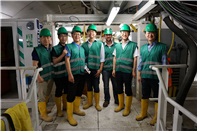 |
| <Regular research meeting (2021)> | <Job site visiting (2018)> |

[The Research Committee of Transportation Geotechnics]
○ Purpose of establishment
The ground foundation for various transportation facilities such as roads, railways, and airports is used to both maintain functionality through the repeated traffic loads and house various utility supply lines such as water, sewers, communication and subway tunnels. Although it is a space to support and host many important utilities, frequent road collapses are occurring on a regular basis, and therefore, intensive researches in minimizing such accidents are necessary. This research society will address all ground engineering issues related to the foundations where transportation facilities such as roads, railways, and airports are located. Its goal is to study the effects of foundation materials along with the effects of large structures on the ground characteristics, through laboratory and field examinations as well as numerical analysis. Functionalities of the underground space that hosts public utilities, such as water supply, water drainage, sewerage, communications and subway tunnels, will also be considered in the engineering point of view. This society will also study methods in predicting and evaluation the various road collapsing phenomena.
○ Main topics
-
All the foundation engineering issues related to transportation facilities such as roads, railways, and airports
- ➀ Laboratory and field studies as well as numerical analyses for the characteristics of foundation materials which is subjected to cyclic traffic loads
- ➁ Engineering problems of the foundations related to the large construction structures
- ➂ Functionalities of spaces that accommodate various utilities such as water, sewerage, communication, and subway tunnels
- ➃ Studying prediction and evaluation methods for the road collapsing phenomena
- ➄ Other transportation facilities
<Committee Chair>
ㅇ Seck-Yeol Jeong, CEO (SREnc, e-mail: jsy5163@hanmail.net)
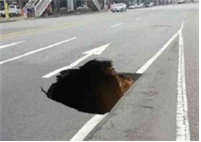 |
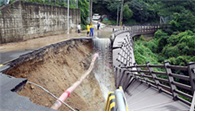 |
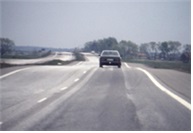 |

[The Research Committee of Railroad Geotechnics]
○ Purpose of establishment
The establishment of the research committee of Railroad Geotechnics is under contemplation in March of 2022 based on the need for a more systematic establishment of railroad construction technology and relevant design standards due to the recent increase in demand for the domestic railroad industry. In addition, the committee aims to facilitate academic and in-practice exchanges among experts in railroad geotechnics. The research committee of Railroad Geotechnics intends to propose research projects associated with railroad roadbed design and construction, railroad tunnels, etc., for general and high-speed railroad networks. To achieve these goals, the committee plans to expand the scope of activities of the Railroad Geotechnical Research Council and vitalize the committee through periodical committee meetings, participation in field trips, technical seminars, and research conferences.
○ Main topics
-
All the foundation engineering issues related to transportation facilities such as roads, railways, and airports
- ➀ Research on railroad roadbed design and construction technology
- ➁ Research on railroad tunnel design and construction technology
- ➂ Research on railroad roadbed and tunnel facilites smart maintenance technology
- ➃ Derivation of amendments through review of railroad design standards and railroad design manuals
<Committee Chair>
ㅇ Chan Yong Choi (Korea Railroad Research Institute, e-mail: cychoi@krri.re.kr)
Regional & other technical committees (Please click on each region for details)
Gangwon (Korea)
Gwangju-Honam (Korea)
Incheon (Korea)
Daejeon-Chungcheong (Korea)
Daegu-Gyungbuk (Korea)
North America (USA)
Geo-Women

[The Regional Technical Committee of the Gangwon Region]
○ Purpose of establishment
The technical Committee of Gangwon Region was established in 2009 to develop scholarship and technical abilities of geotechnical engineering and to contribute the Korea Geotechnical Society.
The committee is conducting various activities centered on the steering committee members and members of the society majoring in geotechnical engineering or performing work in the geotechnical field around the Gangwon province. The committee holds academic seminars to exchange the state-of-the-art technologies, research achievements, and construction results in the geotechnical field, and conduct site tours to share field cases where the latest geotechnical technology is applied in Gangwon province. In addition, the Steering Committee is steadily conducting activities for exchange of people such as small group meetings, steering meetings, and hiking.
Recently, the role of geotechnical engineering is becoming more important along with increasing uncertainties in the construction industry, unusual weather forecast, and various natural disasters. In particular, geotechnical engineering plays a crucial role in preventing and overcoming disasters such as typhoons, torrential rains, heavy snow, and forest fires in Gangwon Province. The Technical Committee of Gangwon Region in Korea Geotechnical Society is operating the best at its center.
○ Main topics
The Technical Committee of Gangwon Region shares academic achievements, latest technologies, and research result of geotechnical engineering through steering meetings, academic seminars, and site tours. The committee also holds various small group meetings to promote friendship between members. We would contribute to the development of the domestic and foreign geotechnical engineering as well as the Gangwon region.
- ① Hosts steering meetings and academic seminars to share state-of-art technology of geotechnical engineering
- ② Organizes site tours for sharing field cases of geotechnical technologies in around Gangwon province
- ③ Consultation and technical support related to geotechnical engineering in Gangwon province
- ④ Arranges technical exchanges with headquarter and other technical committees
<Committee Chair>
ㅇ Dr. Sang-Hyun Jun (POSCO E&C, e-mail: clays@poscoenc.com)
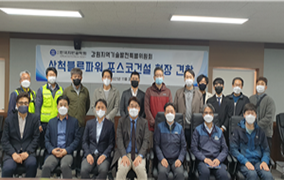 |
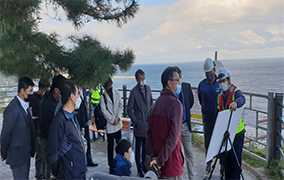 |
| <Site tour in 2021> | |

[The Regional Technical Committee of the Gwangju-Honam Region]
○ Purpose of establishment
This committee aims to promote academic and in-practice exchanges among geotechnical engineers within the Gwangju-Honam region. Furthermore, academic seminars and steering committees are held periodically to achieve committee goals. This committee promotes mutual friendship among the committee members and introduce the latest research conducted by local universities, which may improve the technical skills of local engineers. In addition, by holding the soft ground symposium in the southwest region every two years, the main association of the Korean Geotechnical Society and the members of the Geotechnical Society are also interacting with each other.
○ Main topics
The technical committee for Gwangju-Honam helps the civil engineering society by holding periodical operational meetings and academic seminars to share academic achievements and research outcomes in the field of geotechnical engineering. In addition, the technical committee aims to contribute to the civil engineering industry by sharing case studies of practical applications at construction sites and foundation-related technical works.
- ① Hosts operational meetings and academic seminars to share the latest geotechnical technologies
- ② Organizes site tours for sharing the example of applying the state-of-art technologies
- ③ Held Soft ground Symposium in Southwest region
<Committee Chair>
ㅇ Ph.D. Baek, Won Jin (CHONNAM NATIONAL UNIVERSITY, e-mail: bwj215@jnu.ac.kr)
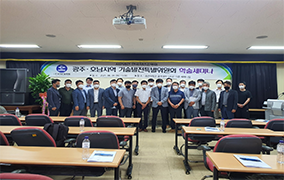 |
|
| <Technical seminar of Gwangju-Honam region TC (2021)> |

[The Regional Technical Committee of the Incheon Region]
○ Purpose of establishment
The technical committee of the Incheon region was established in 2009 after a special seminar hosted by the Korea Geotechnical Society and Incheon Metropolitan City. Establishing the geotechnical technical committee in the Incheon region is more meaningful because even though the Incheon region is the 3rd largest city in Korea, most of the organizations for regional divisions are centered in Seoul due to the geographical condition of being adjacent to Seoul.
The Incheon Regional Committee will take the lead in the development of the community by collaborating with experts in the various geotechnical field. Moreover, members of the technical committee will put all efforts into supporting various organizations in the field of geotechnical engineering and city development.
○ Main topics
The Incheon Regional Committee holds regular operational meetings and academic seminars to share lastest academic achievements and research data based on the construction of various urban structures such as urban railways, marine bridges, and urban development projects in the Incheon area. Moreover, the activities of the committee is contributing to the development of geotechnical engineering and Incheon community.
- ① Host technical and academic seminars and management meetings on urban development in Incheon
- ② Field trips to share various field cases
- ③ Convergence of urban planning technology and geotechnical engineering technology in Incheon area and participation in urban development policy
- ④ Technical exchange with other expert committees
<Committee Chair>
ㅇ Prof. Ki-il Song (INHA UNIVERSITY, e-mail: ksong@inha.ac.kr)
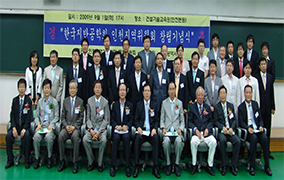 |
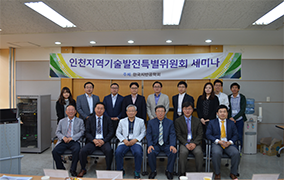 |
| <Founding anniversary seminar for Incheon regional technical committee(2009)> | <Workshop of Incheon regional committee(2020)> |

[The Regional Technical Committee of the Daejeon-Chungcheong Region]
○ Purpose of establishment
Ten years after the establishment of Sejong City, a network of industry, academia, research institutes, and government in the central region have been formed in Daejeon-Chungcheong regions, and cooperative governance has been established for the development of next-generation science and technology. In particular, civil engineering works are actively carried out in the Daejeon and Chungcheong regions. Sejong City, Naepo New Town, and large-scale industrial complexes are expected along with metropolitan railway. Accordingly, in 2011, centered on Daejeon and Chungcheong regions, we promoted academic and technical exchanges and friendships between geotechnical experts in academia, research institutes, relations, and industry. Moreover, the regional technical committee of Daejeon-Chungcheong is in a significant position in location and status. We are creating a forum and seeking cooperation on local issues.
○ Main topics
The technical committee of Daejeon-Chungcheong holds regular steering meetings, technical seminars, and case studies to develop geotechnical technology in the local community.
- ① Hosts semi-annual technical seminars and operational meeting for friendship and technical exchange among members of the Daejeon-Chungcheong regions
- ② Organizes site tours in Daejeon and Chungcheong regions
- ③ Formation of a consultative group to resolve local issues of geotechnical engineering in Daejeon and Chungcheong regions
- ④ Exchange with related societies in the Daejeon-Chungcheong regions and participation in conferences
- ⑤ Arranges continuous technical exchanges with other technical committees and regional technology committees
<Committee Chair>
ㅇ Dr. Young-Suk Song (Korea Institute of Geoscience and Mineral Resources, e-mail: yssong@kigam.re.kr)
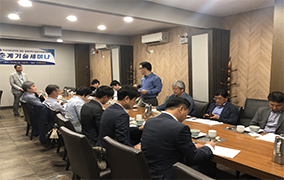 |
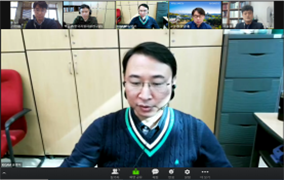 |
| <Spring technical seminar (2019)> | <Fall meeting (2020)> |

[The Regional Technical Committee of the Daegu-Gyeongbuk Region]
○ Purpose of establishment
Daegu-Gyeongbuk region is located at Baekdudaegan Mountains Range as a center of transportation and distribution in the east Korea peninsula, including highways, railroads, and pipelines through both Seoul~Busan axis and Honam~Yeongdong axis. The committee aims to develop and lead geotechnology and academic activities in the Daegu-Gyeongbuk region and support geotechnical professionals and industry-government-academic-research system.
○ Main topics
The committee periodically helps the geotechnical community by holding committee meetings and academic seminars to share lastest geotechnical advancements and research outcomes in Daegu-Gyeongbuk region to improve the Korean Geotechnical Society. In addition, the regional committee aims to exchange techniques through Korean geotechnical engineering community by sharing outcomes in the industry-government-academic-research system and case studies of practical applications on geotechnical works.
- ① Hosts periodic meetings and academic seminars to share the latest geotechnical technologies in Daegu-Gyeongbuk region.
- ② Organizes site tours for sharing the example of applying the latest technologies
- ③ Arranges continuous technical exchanges with other regional committees and the Korean Geotechnical Society.
<Committee Chair>
ㅇ Prof. Joon-Shik Moon (Kyungpook National University, e-mail: j.moon@knu.ac.kr)
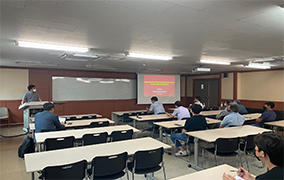 |
 |
| <2021년 정기 세미나 및 간담회> | <2021년 운영위원회 및 송년회> |

[The Regional Technical Committee of the Korean Geotechnical Society-North America (KGS-NA)]
○ Purpose of establishment
By uniting Korean researchers, engineers, and students related to geotechnical engineering in North America, the major goals of the committee are to share new technologies, academic achievements, and the latest geotechnical information, and to promote exchanges between Korean geotechnical engineers in North America. This committee was established in 2017 under the presidentship of Dr. Chung R. Song at the University of Nebraska-Lincoln. Also, on behalf of the Korean Geotechnical Society, we pursue academic exchanges with the ASCE Geo-Institute and promote the development in geotechnical engineering in Korea. We also encourage Korean students studying geotechnical engineering and related fields to actively engage in the professional communities and support their successful career advancement in North America. In addition, we intend to inspire the next generation in geotechnical engineering.
○ Main topics
The KGS North American Committee holds regular operational meetings, academic workshops, and seminars to share the latest academic achievements and research outcomes in North America, contributing to the exchanges between Korean geotechnical researchers, engineers, and students in North America. In addition, it contributes to the globalization of geotechnical engineering in Korea by hosting international scholarly events with the ASCE G-I.
- ① Holds operation meetings monthly to exchange the latest geotechnical technologies in North America
- ② Hosts an annual US-Korea workshop jointly with the Korean Geotechnical Society (YGE Forum)
- ③ Hosts a KGS and G-I workshop in association with the ASCE Geo-Institute biennially
- ④ Shares the latest geotechnical research outcomes in North America
- ⑤ Continues technical exchanges with other specialized subcommittees and vitalization of academic societies
- ⑥ Supports fellowship and travel grant graduate students in the field of Geotechnical Engineering
<Committee Chair>
ㅇ Prof. Soonkie Nam (Georgia Southern University, e-mail: snam@georgiasouthern.edu)
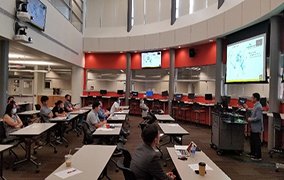 |
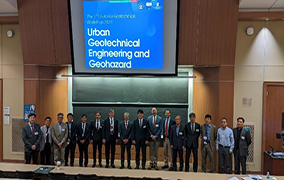 |
| The 3rd US-Korea workshop (2021 | The 1st 2022 G-I and KGS Joint Workshop |

[The Committee of Geo-Women]
○ Purpose of establishment
Of the 12,000 active members enrolled in the ‘Korean Geotechnical Society’ only one hundred members are women. However, in comparison to the number of female members in 1990s’, which amounted to less than 10, it can be seen that the number of female participants have significantly increased. To encourage the female members academic activities and to support their careers as engineers, the ‘Women’s Committee’ was launched in 2019. Additionally, in 2020, this committee joined as a corporate member of the ‘Korean Federation of Women’s Science and Technology Associations’ and conducted a group support project named ‘Geo-Women on Site’ in 2021.
○ Main topics
-
Mentoring of female members, technology exchange to enhance soft power
- ➀ Korean Federation of Women's Science and Technology Associations activities; attending workshops, seminars, and interviews
- ➁ ‘Geo-Women on Site,’ a group support project for the Korean Federation of Women's Science and Technology Associations, was held in 2021
- ➂ Seminar for promoting the soft-power
- ➃ Women’s Committee Professional Session was operated in 2021 Korea Geotechnical Society Fall conference
- ➄ Visiting for the member mentoring; University and graduate school
<Committee Chair>
ㅇ Eun-Ah Hwang, CEO (Mirae Geotech Lab, e-mail: seacreen@hanmail.net)
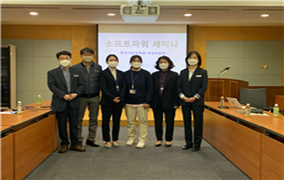 |
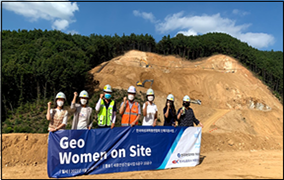 |
| <Soft-power Seminar (2020)> | <‘Geo-Women on Site’ field trip (2021)> |

 HOME
HOME SEARCH
SEARCH

